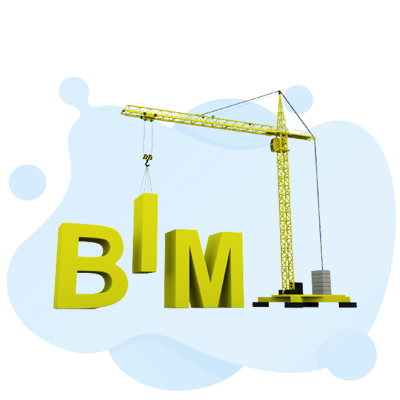Building Information Modeling 2023

The building information model was produced for three alternative design concepts, each with three different cost scenarios. The owner was able to virtually walk through each model. Collaborative 3D viewing sessions were then arranged for the decision-making process. This process proved to be highly beneficial for the project. The owner was able to view each option and make the final decision based on a collaborative model.
Free Building Information Modeling Practice Test Online
Building Information Modeling Questions and Answers
Building Information Modeling
BIM software is used to plan, design, create, and run BIM models, which are used to model and optimize projects.
Building information modeling (BIM) is the cornerstone of the AEC sector’s digital transformation.
Building information modeling is a tool for problem-solving that successfully communicates a plan for building construction.
- Determine your objectives
- Select a pilot project
- Create procedures and enhance existing processes
- Construct your BIM hotel
- Boost communication
- Keep an eye on the project’s progress.
Building information modeling is a process that generates and manages digital representations of a place’s physical and functional properties using a variety of tools, technologies, and contracts.
A BIM modeler uses building information modeling software to produce a project’s three-dimensional visual layout.
Building information modeling (BIM) engineers plan, design, and oversee BIM and detect and fix implementation-related issues and problems. They also ensure that the connected construction projects’ outputs are of a high standard.
- Autodesk Revit
- Plannerly
- Trimble Connect
- Revizto
- BIMCollab
- Dalux
- Autodesk Construction Cloud ACC / BIM 360 ACC BIM Software
- Graphisoft ArchiCAD
- Solibri Model Checker
- BricsCAD BIM
Using BIM improves decision-making, offers more sustainable solutions, and reduces costs for AEC projects.
Building information modeling (BIM) produces an intricate, three-dimensional digital prototype of a future building or piece of infrastructure. This makes it possible to effectively visualize a project, reducing risk and assisting in the optimization of the design process.
BIM enables design and construction teams to operate more productively and capture the data generated during the process for use in operations and maintenance tasks.
Building Information Modeling Consulting Companies
The building information modeling (BIM) process transforms analog information into a digital model. This model includes data and geometry and is the foundation for building design, construction, and operations optimization. Building Information Modeling consulting companies can help companies identify and solve building-related challenges. These solutions can range from optimal space planning to energy model simulations. Furthermore, they can reduce design errors and improve communication between stakeholders.
Building Information Modelling is an increasingly important part of the construction industry. It enables increased design efficiency, streamlines workflows, and improves collaboration. Using BIM services, companies can improve every aspect of the planning, construction, and operations and maintenance process. Microdesk, for example, provides BIM services. These solutions leverage industry best practices to deliver integrated solutions for construction, planning, and operations and maintenance.
BIM services are provided by teams of architects, engineers, and management consultants. They also offer structural and MEP modeling, laser scanning, and as-built services. The company is union and minority-owned, and has completed more than 100 projects. Moreover, it is composed of tradesmen who are actively involved in all stages of the project.
BIM Building Information Modeling
Building information modeling (BIM) is a way of managing building information. It has many benefits, including helping the project team to work more collaboratively and ensuring accurate project specs. It can also help in documentation and maintenance. ArchiCAD is one of the software tools that support BIM. ArchiCAD creator Mary Moscarello describes BIM in a different light.
Building information modeling (BIM) can reduce the cost of a project. BIM can streamline the project planning process, allowing team members to review contract documents and identify missing items. It can also be used to prepare coordinated shop drawings, which are then issued to subcontractors. Building information modeling provides a better understanding of the entire project and helps avoid costly mistakes during construction.
Several companies develop BIM software. AutoDesk, Bentley, and Graphisoft all offer BIM software platforms. Some companies focus on the process aspect of the BIM process, while others focus on the technology.
Building Information Modeling Solution Companies
Using Building Information Modeling (BIM) technology is an excellent way for designers, engineers, and architects to see their upcoming projects in 3D. It helps them understand the space they are designing and minimizes setbacks and delays. In addition, BIM allows them to edit the building information themselves and avoid inconsistencies.
BIM software can simulate a building’s structure, materials, and systems in great detail. It can be used for forensic analysis, renovation, space planning, maintenance, and more. Building Information Modeling is a versatile tool that helps create faster processes and reduce costs. It also allows for rigorous analysis of design proposals, and it is easily reusable.
Market trends in the Building Information Modeling (BIM) market are fueled by the increasing need to streamline construction processes. Increasingly, the AEC industry is adopting building information modeling solutions to improve the overall productivity of construction projects. Growth in this segment is predicted to continue in the years ahead, due to the increased adoption of cloud-based BIM software.
Building Information Modeling Software
Building Information Modeling (BIM) software creates a virtual model of a building. This model shows all the elements of a building and allows designers and engineers to create a model of a facility before construction begins. When everyone on the project agrees on the virtual design, physical construction can begin. If the design changes, the team can go back and edit it until everyone is satisfied. There are several computer software techniques that are used to create this digital blueprint.
Building Information Modeling software is a popular way to manage large projects. It allows a project manager to manage resources more effectively. The software also provides insight into the workflow process. Building information modeling software can save a team time and money by eliminating tedious paperwork. For instance, if a building manager is responsible for planning and managing the project, they will be able to save a huge amount of time by reducing the amount of data that they need to collect.
BIM software is also useful for managing the lifecycle of a building. It allows stakeholders to review the model to ensure it meets all specifications. The software can also help a project run smoothly on time and within budget. In addition, BIM software can be used to create data-backed reports that can help decision-makers make informed decisions.
Building Information Modeling Energy Engineering
Building information modeling (BIM) is a digital process that allows engineers to analyze energy savings opportunities and optimize buildings. BIM utilizes information gathered at key project stages to produce a 3D model of the building’s physical and functional characteristics. This type of model also facilitates life cycle data management. As a result, BIM has been recognized as an important tool in the energy engineering field.
Building Information Modeling can be used anytime during the lifecycle of a building. In some cases, it is used at the design stage, during the construction process, and after. The information from earlier models is used to inform decisions at subsequent stages of the project. However, it is more common to use information from energy modelling during the design stage. This approach also yields more accurate information, which can help engineers create better buildings.
To implement BEM, energy performance data is collected during the design phase. This information is stored in BIM’s data repository. When this information is collected, it can be used to predict how much energy the building will consume in the future. The data is used to inform design and construction decisions.

Building Information Modeling Service Companies
Building information modeling (BIM) is a revolutionary new way to design a building. This method integrates a variety of technical disciplines into a single model, allowing for greater efficiency and accuracy. 3D CAD models can be created using laser scanning technology and surveys, and can be used for many different purposes, from identifying utility conflicts to identifying the exact location of rooms and other areas. Additionally, BIM models can be updated during construction and even after final completion.
When used correctly, BIM allows for unprecedented collaboration among all participants in the building process. It allows for the precise location of differences and discrepancies, reducing the possibility of costly mistakes during construction. Because BIM helps in the coordination of significant disciplines, it has the potential to make construction faster and more cost-effective.
With BIM, accurate quantities of all design elements can be determined. This information can then be used to procure materials from vendors and subcontractors. It can also be updated to reflect changes made to the building during construction. The updated model provides an accurate representation of as-built spaces and building systems, making it an essential starting point for the operation and management of the building.
Building Information Modeling Masters
A Master’s degree in Building Information Modelling (BIM) will equip you with the skills and knowledge to create and manage building information models. This discipline combines wide-ranging construction knowledge and graphics expertise. It is becoming the norm in the Built Environment. You’ll graduate with a master’s degree in BIM and be well-prepared to lead construction projects. There are a number of ways to study BIM.
Master’s degree programs are offered internationally and offer the flexibility to study at any time. You can complete a one-year Master’s degree in BIM by choosing a partner university. You will be taught in English throughout the course. In addition, you will also learn about various standards across the globe, including buildingSMART ISO, BRE, and Uniclass.
Introduction to Building Information Modeling
Building information modeling is a process that builds a digital representation of a building’s physical and functional characteristics. This model serves as a shared knowledge base and requires collaboration between a variety of stakeholders. In many cases, it takes the form of a database of interrelated files. Its advantages are many, and it can help commercial real estate professionals make better decisions.
BIM is becoming more widely recognized as an industry best practice, and it provides a series of technologies and processes to improve productivity and efficiency. This introductory course covers the terminology and concepts of BIM and explores the benefits and practical application in the construction industry. It also introduces multiple modeling software. Throughout the course, students will develop a basic understanding of the software required for BIM.
In addition to construction planning, BIM is also used in the construction industry to help with conflict detection and collisions. The software can even be used in forensic analysis. It can also be used in space planning, renovations, and maintenance operations. Building information models can also be used to simulate future designs and build proposals.
